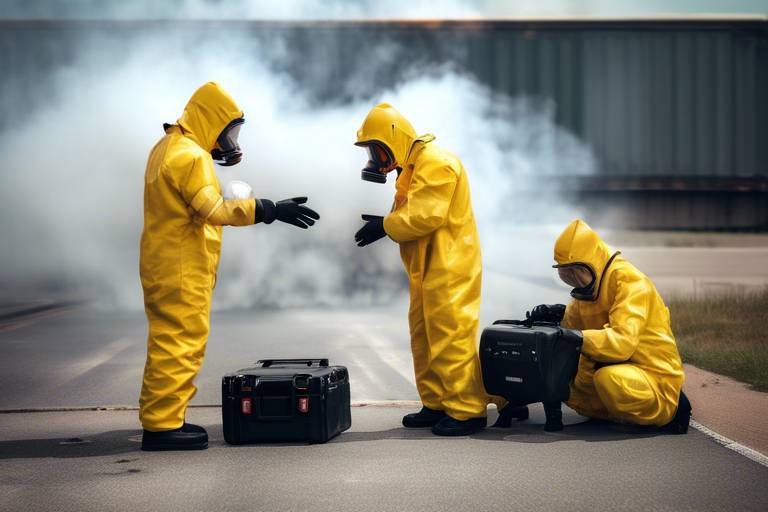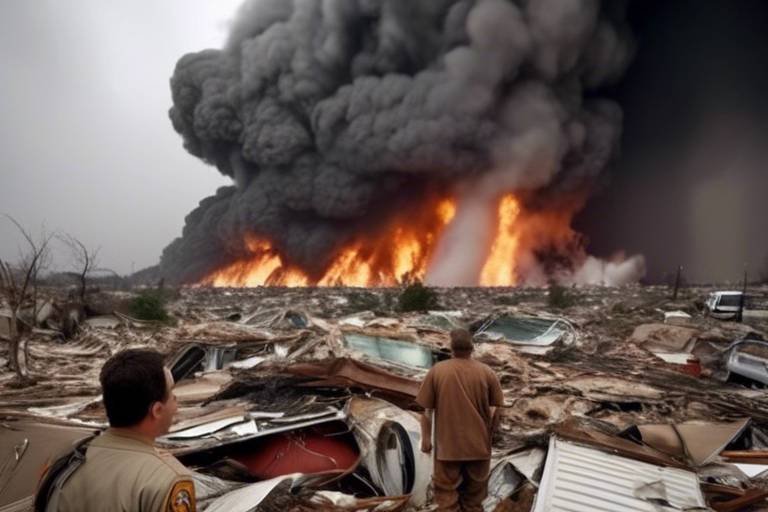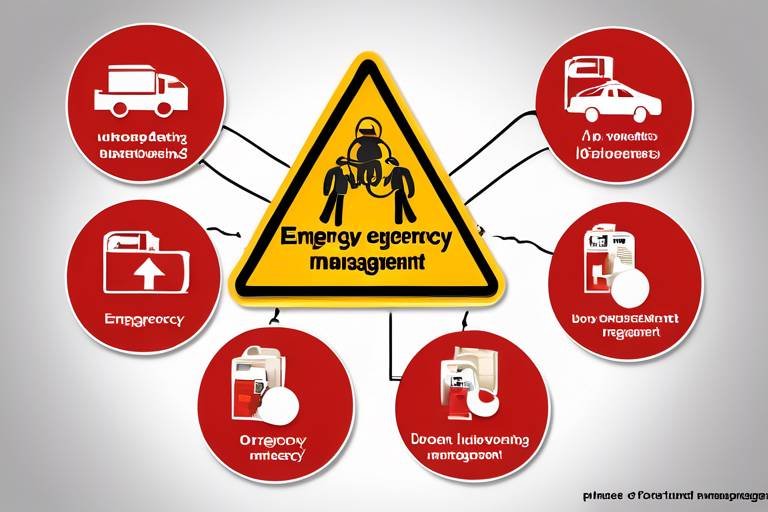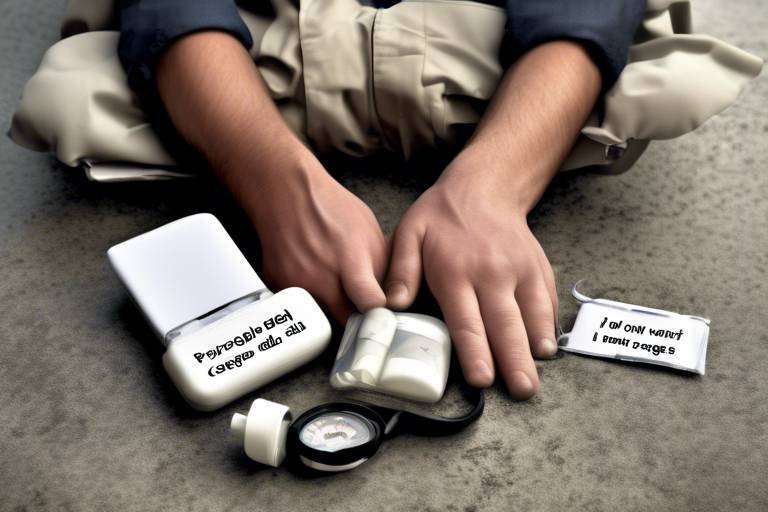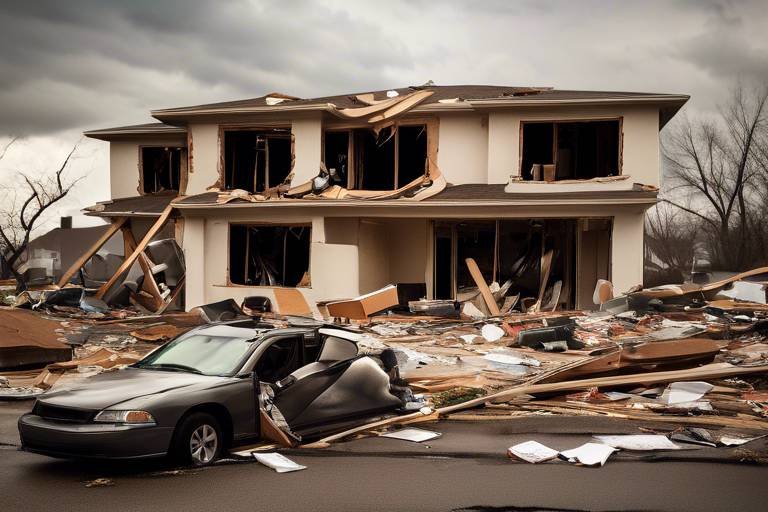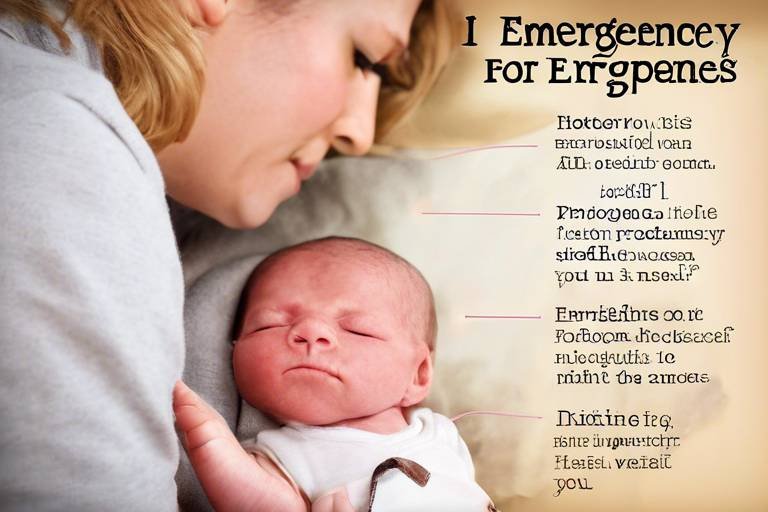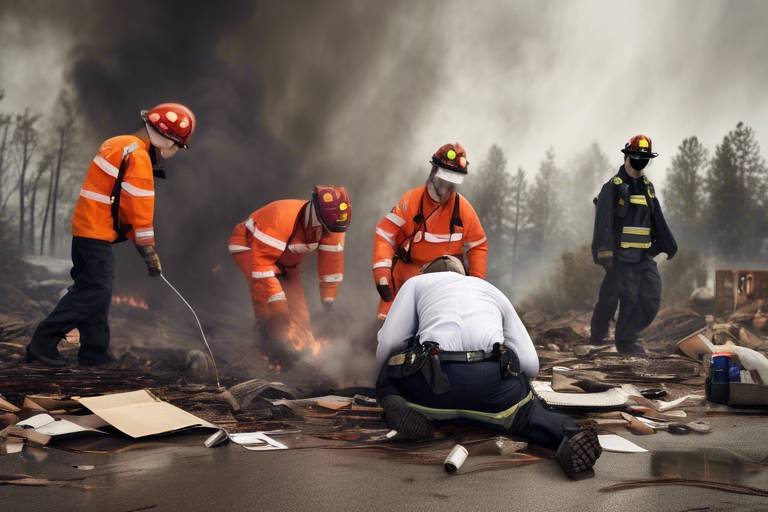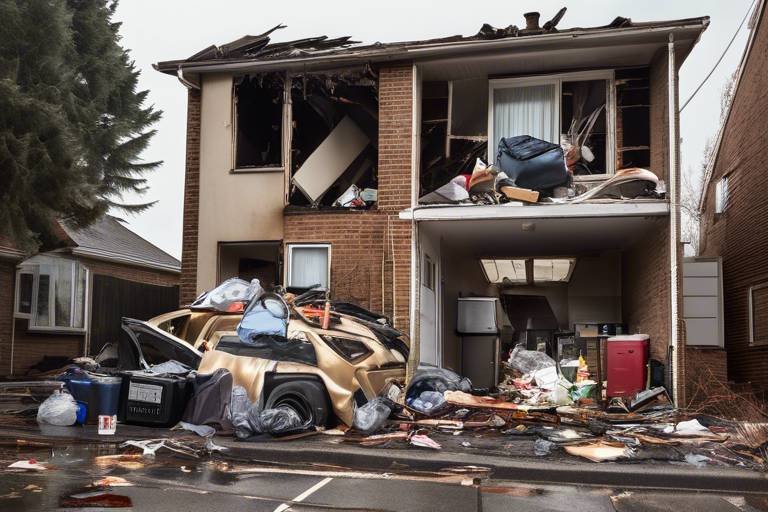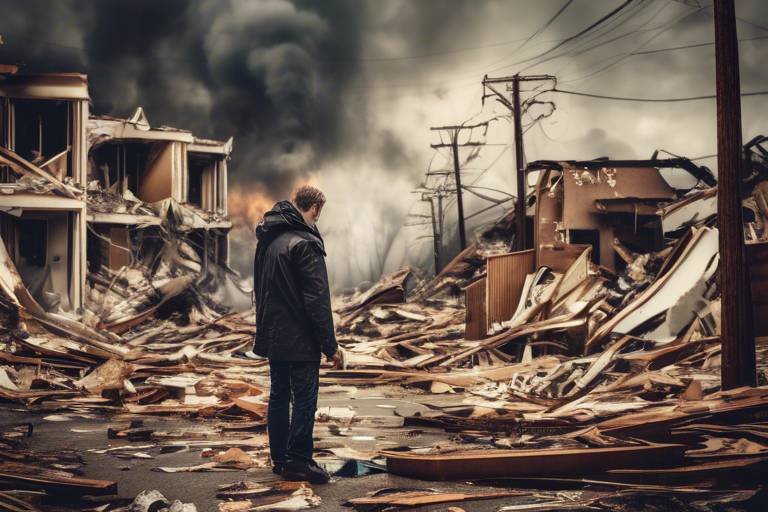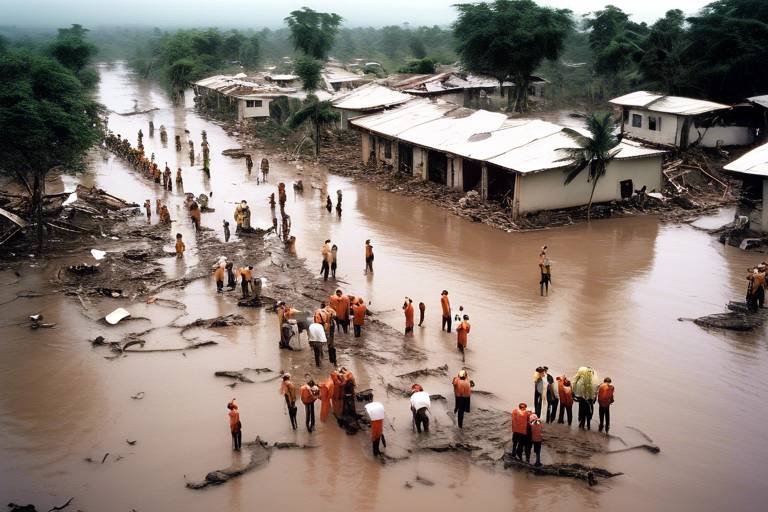The Role of Mobile Apps in Emergency Response
This article explores how mobile applications enhance emergency response efforts, streamline communication, and improve overall efficiency during crises, ultimately saving lives and resources in critical situations.
Effective communication is vital during emergencies. Mobile apps facilitate real-time updates and information sharing among responders, agencies, and the public, ensuring everyone is informed and coordinated in their efforts. Imagine a scenario where a natural disaster strikes; the ability to share crucial information instantly can make all the difference. For instance, emergency services can send alerts about evacuation routes or shelter locations to affected individuals, allowing them to make informed decisions quickly. This instantaneous communication can be the difference between chaos and order during a crisis.
Mobile applications enable the collection of real-time data, such as location tracking and incident reporting. This data is crucial for making informed decisions and allocating resources efficiently during emergencies. Think about it—when every second counts, having access to accurate, up-to-the-minute information can significantly enhance response strategies. With mobile apps, responders can gather data from various sources, including citizen reports, which can help in assessing the situation more accurately.
Location tracking features in mobile apps help responders identify affected areas quickly, allowing for faster deployment of resources and personnel to where they are needed most during a crisis. This capability is akin to having a GPS navigation system in a chaotic environment, guiding responders directly to the heart of the emergency. For example, if a flood occurs, responders can use location data to pinpoint the most severely impacted neighborhoods and prioritize their efforts.
Geofencing technology allows emergency services to set virtual boundaries, alerting them when individuals enter or exit specific areas, which can be critical for managing evacuations or monitoring disaster zones. This is especially useful in scenarios like wildfires, where knowing who is in danger can facilitate timely evacuations. By receiving alerts when someone enters a hazardous area, responders can act swiftly to ensure safety.
Integrated mapping and navigation tools in mobile apps assist responders in navigating complex environments, ensuring they reach affected locations promptly and effectively during emergencies. Imagine trying to find your way through a maze of debris after a hurricane; these tools can help clear the path. Additionally, they can provide real-time updates on road closures and alternative routes, ensuring that responders can adapt their plans on the fly.
Mobile apps equipped with incident reporting tools enable citizens to report emergencies quickly, enhancing situational awareness for responders and facilitating a more coordinated response effort. This creates a two-way communication channel between the public and emergency services. When citizens can easily report incidents, it helps responders prioritize their actions based on the most pressing needs, enhancing overall efficiency.
User-friendly interfaces are crucial for ensuring that both responders and civilians can use mobile apps effectively during emergencies, even under stress. Simplicity and accessibility can significantly impact response times. If an app is too complicated, users might struggle to find the information they need when every second counts. Therefore, designing apps with intuitive layouts and clear instructions is paramount.
Designing mobile apps with accessibility in mind ensures that individuals with disabilities or those in high-stress situations can still navigate and utilize the app effectively during emergencies. This inclusivity is not just a nice-to-have; it is essential. For example, voice commands and visual aids can be invaluable for users who might have difficulty using traditional interfaces, ensuring that everyone can access critical information when they need it most.
Providing training and support for users helps maximize the benefits of mobile apps in emergency response, ensuring that all stakeholders are familiar with the features and functionalities available to them. Think of it as preparing for a big game; the more you practice and understand your tools, the better you perform under pressure. Regular training sessions can empower users, making them more confident and effective during emergencies.
Examining case studies of successful mobile app implementations in emergency response highlights best practices, lessons learned, and the positive impact these technologies have had on crisis management efforts. For instance, during the 2017 hurricane season, apps like FEMA's mobile app provided real-time updates and resources, proving invaluable for both responders and the public.
Analyzing how mobile apps have been used during natural disasters showcases their effectiveness in improving coordination, communication, and resource allocation among emergency responders and affected communities. The data collected and shared through these apps can lead to better preparedness and response strategies for future disasters.
Mobile apps have played a crucial role in managing public health emergencies, such as pandemics, by facilitating information dissemination, tracking symptoms, and coordinating vaccination efforts among the population. By providing a platform for individuals to report symptoms and receive updates, these apps have helped streamline public health responses, ultimately saving lives.
The future of mobile apps in emergency response is promising, with advancements in technology, artificial intelligence, and data analytics poised to further enhance their effectiveness and capabilities in crisis situations. As technology evolves, so too will the tools available to emergency responders, making it easier to manage crises efficiently.
Integrating artificial intelligence into mobile apps can improve predictive analytics, enabling responders to anticipate emergencies and allocate resources proactively based on historical data and trends. This proactive approach can revolutionize how we prepare for and respond to emergencies, potentially reducing the impact of disasters before they even occur.
As mobile apps become more integral to emergency response, enhancing security features will be essential to protect sensitive data and ensure user privacy during critical situations. This is crucial in maintaining public trust and ensuring that individuals feel safe using these technologies during emergencies.
- How do mobile apps improve communication during emergencies?
Mobile apps allow for real-time updates and information sharing, ensuring that all parties involved are informed and coordinated. - What role does location tracking play in emergency response?
Location tracking helps responders quickly identify affected areas and deploy resources effectively. - Are mobile apps accessible for individuals with disabilities?
Yes, many mobile apps are designed with accessibility in mind, ensuring that everyone can use them effectively during emergencies. - How can AI enhance emergency response apps?
AI can improve predictive analytics, helping responders anticipate emergencies and allocate resources proactively.

Improving Communication
Effective communication is absolutely vital during emergencies. Imagine a chaotic scene where every second counts; in such moments, clear and timely information can make the difference between life and death. Mobile applications are stepping up to the plate, facilitating real-time updates and information sharing among responders, agencies, and the public. This ensures that everyone is informed and coordinated in their efforts, ultimately enhancing the overall response to crises.
One of the standout features of these mobile apps is their ability to provide instant notifications. For instance, when an emergency occurs, responders can receive alerts about the situation immediately. This is not just about sending out a message; it's about creating a network where information flows seamlessly. Think of it as a digital command center right in your pocket. This level of connectivity allows for a more synchronized response, reducing the chances of miscommunication that can lead to disastrous outcomes.
Moreover, mobile apps can serve as platforms for public engagement during emergencies. Citizens can report incidents, share vital information, and even receive updates directly from local authorities. This two-way communication is crucial, as it empowers the public to contribute to the emergency response efforts. For example, during a natural disaster, individuals can use these apps to report flooding in their area, which can then be relayed to emergency services for a quicker response.
To illustrate the importance of communication in emergency response, let’s take a look at some key features that enhance this aspect:
- Push Notifications: Instant alerts keep everyone informed about the latest developments.
- Chat Features: Real-time messaging allows responders to communicate quickly, sharing critical information without delays.
- Social Media Integration: Many apps can pull in updates from social media, ensuring that responders are aware of what the public is saying and experiencing.
In addition to these features, the ability to share multimedia content, such as images and videos, can significantly improve situational awareness. For example, a citizen might upload a video showing a blocked road, which can help responders reroute their efforts efficiently. This not only aids in resource allocation but also provides a clearer picture of the ground realities.
In conclusion, mobile applications are revolutionizing the way we communicate during emergencies. By providing real-time information, facilitating public engagement, and enabling seamless communication among responders, these apps play a crucial role in enhancing the effectiveness of emergency response efforts. The next time you think about mobile technology, remember that it’s not just for social media or games; it’s a lifeline in critical situations.

Real-Time Data Collection
In the chaotic environment of an emergency, having access to real-time data can be a game changer. Mobile applications serve as a vital link between various stakeholders, allowing for the swift collection and dissemination of information. Imagine being in the midst of a natural disaster, where every second counts. The ability to gather data such as location tracking and incident reports can significantly influence the effectiveness of the response. By utilizing mobile apps, emergency responders can make informed decisions that directly impact the safety and well-being of those affected.
One of the most crucial aspects of real-time data collection is location tracking. This feature allows emergency teams to pinpoint affected areas quickly, ensuring that resources and personnel are deployed where they are needed most. For instance, during a flood, responders can use mobile apps to identify neighborhoods that are submerged and prioritize their rescue efforts. This not only saves time but can also save lives.
Location tracking features in mobile applications are equipped with advanced technologies such as GPS and geolocation services. These tools enable responders to:
- Identify high-risk areas that require immediate attention.
- Monitor the movement of personnel and resources in real-time.
- Provide accurate information to the public about safe routes and evacuation points.
Moreover, the integration of geofencing capabilities can further enhance the efficiency of emergency responses. Geofencing technology allows responders to set up virtual boundaries around specific areas. Whenever individuals enter or exit these zones, alerts are triggered, providing critical information for managing evacuations or monitoring disaster zones. This feature is particularly beneficial during situations like wildfires, where quick decisions are necessary to protect lives.
Another vital component of real-time data collection is the mapping and navigation tools embedded within mobile applications. These tools assist responders in navigating complex environments, especially during crises when traditional routes may be blocked or unsafe. With integrated mapping, responders can:
- Access updated maps that reflect current conditions.
- Plan optimal routes to reach affected areas swiftly.
- Coordinate with other teams to avoid redundancy and ensure comprehensive coverage.
By leveraging these technologies, emergency responders can enhance their situational awareness, leading to a more coordinated and effective response effort. The ability to collect and analyze data in real-time not only improves decision-making but also fosters a sense of trust among the community, as citizens can see that help is on the way.
Mobile applications equipped with incident reporting tools empower civilians to report emergencies quickly and efficiently. This feature enhances situational awareness for responders, as they receive immediate updates about ongoing incidents from the public. The faster the information flows, the quicker the response can be, creating a synergy between the community and emergency services.
In summary, the integration of real-time data collection through mobile applications is revolutionizing the way emergency responses are conducted. By harnessing the power of technology, we can ensure that help arrives faster and more efficiently, ultimately saving lives and resources in critical situations.
Q: How do mobile apps improve emergency response?
A: Mobile apps improve emergency response by facilitating real-time communication, data collection, and coordination among responders and the public, which enhances overall efficiency during crises.
Q: What role does location tracking play in emergencies?
A: Location tracking helps responders quickly identify affected areas, allowing for faster deployment of resources and personnel where they are most needed.
Q: Can anyone use incident reporting tools in mobile apps?
A: Yes, incident reporting tools are designed for public use, enabling citizens to report emergencies and provide valuable information to responders.

Location Tracking Features
Location tracking features in mobile applications are nothing short of revolutionary when it comes to emergency response. Imagine a chaotic scene where every second counts; having the ability to pinpoint the exact location of incidents can mean the difference between life and death. These features leverage GPS technology to provide real-time data on the whereabouts of both responders and victims, allowing for a swift and effective response.
For instance, during a natural disaster, responders can use location tracking to quickly identify which areas are most affected. This capability enables them to prioritize their efforts, ensuring that help reaches those in dire need without delay. By visualizing the affected zones on a map, emergency services can strategize their deployment of personnel and resources more efficiently. This not only enhances the effectiveness of the response but also optimizes the use of available resources, which can be critically limited during emergencies.
Moreover, location tracking features can be integrated with additional functionalities, such as:
- Emergency Alerts: Users can receive alerts about nearby incidents, prompting them to evacuate or seek shelter.
- Resource Allocation: Responders can see where resources are deployed and where they are needed most, streamlining their operations.
- Public Safety Notifications: Citizens can report their locations during emergencies, helping responders locate individuals who may be trapped or in danger.
One of the standout aspects of location tracking is its ability to work in conjunction with other technologies, such as drones and automated vehicles. For example, drones equipped with GPS can be deployed to survey disaster-stricken areas, providing aerial views that help assess the situation from above. This synergy between different technologies enhances situational awareness and allows for a more coordinated response effort.
In summary, location tracking features in mobile apps are a game changer in emergency response scenarios. They not only facilitate quicker and more informed decision-making but also foster a collaborative environment among responders, agencies, and the public. As technology continues to evolve, we can expect these features to become even more sophisticated, further improving how we manage emergencies and ultimately saving lives.
Q: How does location tracking work in emergency apps?
A: Location tracking in emergency apps typically relies on GPS technology to determine the user's or incident's location in real-time, allowing responders to act quickly.
Q: Are there privacy concerns with location tracking?
A: Yes, privacy is a significant concern. Most emergency apps have strict privacy policies and allow users to control when and how their location is shared.
Q: Can location tracking help in non-disaster scenarios?
A: Absolutely! Location tracking can be beneficial in various situations, such as medical emergencies, missing persons cases, and even during large public events.

Geofencing Capabilities
Geofencing technology has revolutionized the way emergency services operate during crises. By creating virtual boundaries around specific geographical areas, responders can receive immediate alerts when individuals enter or exit these zones. This capability is particularly crucial in scenarios such as natural disasters, where managing evacuations and monitoring disaster zones becomes paramount. Imagine a scenario where a flood is imminent; geofencing allows authorities to quickly identify individuals who may still be in the danger zone and send them timely alerts to evacuate. This proactive approach not only enhances safety but also streamlines the overall response strategy.
Furthermore, geofencing can be integrated with other mobile app functionalities to provide a comprehensive solution for emergency management. For instance, when combined with location tracking features, emergency responders can pinpoint the exact locations of individuals in distress. This synergy ensures that help reaches those in need as swiftly as possible. Additionally, geofencing can be utilized to monitor compliance with evacuation orders, ensuring that everyone is accounted for and safe.
To illustrate the effectiveness of geofencing in emergency response, consider the following key benefits:
- Real-time Alerts: Emergency services can receive instant notifications when someone enters a designated danger zone, allowing for quicker responses.
- Resource Allocation: By understanding where individuals are located, responders can allocate resources more efficiently, directing teams to areas with the highest need.
- Enhanced Safety: Individuals can receive alerts directly on their mobile devices, empowering them to make informed decisions about their safety.
In summary, geofencing capabilities represent a significant advancement in emergency response technology. By leveraging this powerful tool, emergency services can enhance their operational efficiency, improve situational awareness, and ultimately save lives during critical situations.
- What is geofencing? Geofencing is a technology that creates virtual boundaries around specific geographical areas, allowing for real-time alerts and monitoring of activities within those zones.
- How does geofencing benefit emergency response? It allows emergency services to receive immediate notifications about individuals entering or exiting danger zones, facilitating quicker and more efficient responses.
- Can geofencing be integrated with other technologies? Yes, geofencing can be combined with location tracking and incident reporting tools to create a comprehensive emergency management solution.

Mapping and Navigation
In the chaotic moments of an emergency, every second counts. This is where the features of mobile applications come into play, acting like a lifeline for emergency responders. Imagine being in the middle of a disaster zone, with roads blocked and confusion reigning. How do you ensure that help gets to those who need it most? This is where these advanced tools shine. They provide responders with detailed maps that highlight the quickest routes to affected areas, taking into account real-time conditions such as traffic, road closures, and hazards.
Moreover, these applications often integrate GPS technology, allowing responders to pinpoint their exact location and navigate through even the most complex environments. This capability is not just beneficial for the professionals on the ground; it also empowers civilians. For instance, a citizen caught in an emergency can use the app to find the nearest shelter or safe zone, guiding them away from danger.
Additionally, many mobile apps feature interactive maps that can display crucial information such as:
- Locations of emergency services
- Safe evacuation routes
- Areas that are unsafe or hazardous
By providing this vital information at a glance, these tools help to streamline the decision-making process, allowing for faster and more effective responses. The integration of real-time updates into these maps ensures that responders are always working with the most current information, which is essential during rapidly evolving situations.
In summary, the mapping and navigation features of mobile apps are not just supplementary tools; they are essential components of modern emergency response strategies. They transform how responders operate, enhance situational awareness, and ultimately save lives by ensuring that help is delivered precisely where and when it is needed. The next time you think about emergency response, consider the significant role that these digital maps play in orchestrating a swift and effective reaction to crises.

Incident Reporting Tools
In the fast-paced world of emergencies, the ability to report incidents swiftly and accurately can make all the difference. Mobile apps equipped with incident reporting tools empower citizens to play a pivotal role in crisis situations. Imagine a scenario where a natural disaster strikes, and every second counts. With just a few taps on their smartphones, individuals can report emergencies, share vital information, and alert authorities to unfolding situations. This immediacy not only enhances situational awareness for emergency responders but also fosters a sense of community engagement and responsibility during crises.
These tools often come with user-friendly interfaces that simplify the reporting process. For instance, many apps allow users to submit reports with essential details such as location, type of incident, and even photos. This feature is crucial because it provides responders with real-time, actionable data that can be used to assess the situation and deploy resources effectively. In fact, some apps even incorporate geolocation technology, automatically tagging the user's location to ensure that help is dispatched to the right place without delay.
Moreover, the integration of incident reporting tools with social media platforms can amplify their effectiveness. When users report incidents through mobile apps, these reports can be automatically shared on social media, reaching a broader audience and potentially gathering more information from bystanders. This interconnectedness can lead to a more comprehensive understanding of the situation, allowing emergency services to respond more effectively.
To illustrate the impact of incident reporting tools, consider the following table that highlights key benefits:
| Benefit | Description |
|---|---|
| Real-Time Updates | Allows for immediate reporting and response, minimizing delays. |
| Enhanced Situational Awareness | Provides responders with critical information to assess the situation. |
| Community Engagement | Encourages citizens to participate actively in their safety and emergency response. |
| Resource Allocation | Helps in the efficient deployment of resources based on real-time data. |
In conclusion, incident reporting tools in mobile apps are not just a luxury; they are a necessity in today’s emergency response landscape. By enabling quick and efficient reporting, these tools bridge the gap between the public and emergency services, ensuring that help arrives when and where it is needed most. As we continue to innovate and improve these technologies, the potential for saving lives and mitigating the effects of disasters will only grow stronger.
Here are some common questions regarding incident reporting tools in mobile apps:
- How do incident reporting tools work? - These tools typically allow users to report incidents through a mobile app, providing details like location and type of emergency, which are then transmitted to emergency services.
- Can anyone use these reporting tools? - Yes, most incident reporting tools are designed for public use, allowing anyone to report emergencies.
- What information should I include in a report? - It's best to include your location, a brief description of the incident, and any other relevant details such as injuries or hazards.
- Are these apps available for free? - Many incident reporting apps are available for free, though some may offer premium features for a fee.

User-Friendly Interfaces
In the chaotic world of emergencies, having a user-friendly interface in mobile applications is not just a luxury; it’s a necessity. Imagine trying to navigate a complex app when every second counts. A well-designed interface can mean the difference between getting help quickly or facing dire consequences. The goal is to create an experience that is intuitive and straightforward, allowing both emergency responders and civilians to access vital information without unnecessary complications.
When designing these applications, developers must prioritize simplicity. This means using clear language, recognizable icons, and a logical layout. For instance, an app might feature a prominent emergency button that users can tap with one hand, even while multitasking. Furthermore, color schemes should be chosen wisely to ensure visibility in various conditions, such as low light or during a crisis when emotions run high. The interface should guide users effortlessly through the app, reducing the cognitive load during stressful situations.
Accessibility is another critical aspect of user-friendly interfaces. It is essential to consider all potential users, including those with disabilities. By incorporating features such as voice commands, adjustable text sizes, and high-contrast modes, developers can ensure that everyone can utilize the app effectively. This approach not only broadens the app's reach but also reinforces the idea that in emergencies, every second and every person counts.
Moreover, providing training and support for users can significantly enhance the effectiveness of mobile apps in emergency situations. This could involve creating tutorial videos, FAQs, or even live support options to help users familiarize themselves with the app's features before a crisis arises. The more comfortable users are with the technology, the faster they can respond when it matters most. Engaging in community outreach to educate the public about the app can also foster a sense of trust and reliability in the technology.
In conclusion, a user-friendly interface is a cornerstone of effective emergency response apps. By focusing on simplicity, accessibility, and providing adequate support, developers can create tools that empower users to act swiftly and decisively during crises. As we continue to innovate and improve these applications, we can look forward to a future where technology plays an even more significant role in saving lives and resources during emergencies.
- Why is a user-friendly interface important in emergency response apps?
A user-friendly interface allows users to navigate the app quickly and efficiently, which is crucial during emergencies when every second counts. - How can accessibility be ensured in these apps?
By incorporating features like voice commands, adjustable text sizes, and high-contrast modes, developers can make apps usable for individuals with disabilities. - What role does training play in the effectiveness of emergency response apps?
Training helps users become familiar with the app’s features, enabling them to respond more quickly and effectively during emergencies.

Accessibility for All Users
When it comes to emergency situations, accessibility is not just a nice-to-have; it’s a critical necessity. Imagine a scenario where a natural disaster strikes and individuals with disabilities or those who are elderly need to access vital information quickly. If mobile apps aren't designed with accessibility in mind, these users could be left in the dark, quite literally. That's why it's essential to create mobile applications that cater to everyone, regardless of their physical or cognitive abilities.
To achieve this, developers must consider various factors that enhance usability for all users. For instance, incorporating features like voice commands can significantly aid those who may have difficulty using touchscreens. Additionally, using high-contrast colors and larger fonts can help individuals with visual impairments navigate the app more easily. Accessibility isn't just about meeting standards; it’s about creating an inclusive environment where everyone can participate in their own safety.
Furthermore, testing the app with real users who have disabilities can provide invaluable feedback. This approach ensures that the app is not only functional but also user-friendly for those who need it most. It's crucial to remember that in emergencies, every second counts, and if a user struggles to access information or report an incident, it could lead to devastating consequences.
Incorporating accessibility features can be broken down into several key components:
- Screen Reader Compatibility: Ensuring that the app is compatible with screen readers allows visually impaired users to receive information audibly.
- Simple Navigation: A straightforward layout with intuitive navigation helps users find what they need without confusion.
- Customizable Settings: Allowing users to adjust text size and color schemes can make the app more comfortable to use.
- Emergency Hotlines: Providing quick access to emergency hotlines or chat features can be lifesaving.
Ultimately, the goal is to create a mobile app that not only informs but also empowers all users during emergencies. By prioritizing accessibility, we can ensure that no one is left behind when seconds matter most. As we move forward, let’s remember that inclusivity is not just a feature; it’s a fundamental aspect of effective emergency response.
- What are the key features of an accessible emergency response app?
An accessible emergency response app should include screen reader compatibility, easy navigation, customizable settings, and quick access to emergency hotlines. - Why is accessibility important in emergency situations?
Accessibility is crucial because it ensures that everyone, including individuals with disabilities, can access vital information and resources during emergencies. - How can developers test for accessibility?
Developers can test for accessibility by involving users with disabilities in the testing process to gather feedback on usability and functionality.

Training and Support
When it comes to maximizing the effectiveness of mobile apps in emergency response, are absolutely essential. Just imagine being thrown into a chaotic situation with a powerful tool at your fingertips but having no idea how to use it. That’s where comprehensive training programs come into play. They ensure that both emergency responders and civilians are not just familiar with the app, but are also confident in navigating its features even under extreme pressure.
Training should be tailored to the specific needs of the users. For responders, this may include in-depth sessions on using real-time data collection features, incident reporting tools, and location tracking capabilities. For civilians, the training can focus on how to report emergencies effectively, access vital information, and understand alerts. The goal is to create a seamless experience where everyone knows what to do when the stakes are high.
Moreover, ongoing support is crucial. Think of it like having a safety net; users should have access to help whenever they need it. This can take the form of user manuals, online tutorials, or even dedicated helplines. Regular updates and refresher courses can also keep users informed about new features or changes in protocols. The more supported users feel, the more likely they are to utilize the app effectively during real emergencies.
To illustrate the importance of training and support in emergency response apps, let’s consider a few key components:
| Component | Description |
|---|---|
| Initial Training | Hands-on sessions for users to familiarize themselves with app features. |
| Ongoing Support | Access to resources like manuals, tutorials, and help desks. |
| Regular Updates | Training refreshers to keep users updated on new features. |
In conclusion, investing in thorough training and robust support systems not only empowers users but also enhances the overall efficacy of mobile applications in emergency situations. When everyone knows how to use these tools effectively, the chances of a successful response increase dramatically. After all, in emergencies, every second counts, and being prepared can be the difference between chaos and coordinated action.
- What type of training is available for emergency response apps? Training typically includes hands-on sessions, online tutorials, and user manuals to help users navigate the app effectively.
- How often should training be updated? Regular refresher courses should be conducted whenever new features are added or protocols change.
- Is support available 24/7? Yes, having a dedicated helpline or support team accessible at all times can greatly assist users during emergencies.

Case Studies of Successful Implementations
Examining case studies of successful mobile app implementations in emergency response reveals the transformative power of technology in crisis management. One notable example is the use of mobile applications during natural disasters, such as hurricanes and earthquakes. For instance, during Hurricane Harvey in 2017, the City of Houston deployed a mobile app that allowed residents to report flooding incidents in real-time. This app not only facilitated communication between citizens and emergency responders but also helped in mapping out the most affected areas, thereby optimizing resource allocation.
Another compelling case study comes from the COVID-19 pandemic, where mobile apps played a pivotal role in managing public health emergencies. The COVID Alert app, implemented in several countries, enabled users to receive notifications if they had been in close contact with someone who tested positive for the virus. This app served as a crucial tool for contact tracing, helping to contain the spread of the virus. By integrating symptom tracking and vaccination appointment scheduling, the app significantly improved public health response efforts.
In addition to these examples, many communities have developed localized apps that cater to specific needs during emergencies. For example, the MyShake app in California provides earthquake early warnings and safety tips. When an earthquake is detected, the app sends alerts to users seconds before the shaking begins, allowing them to take cover. Such proactive measures can mean the difference between life and death, highlighting the importance of mobile technology in enhancing personal safety.
These case studies illustrate several key benefits of mobile applications in emergency response:
- Enhanced Communication: Mobile apps facilitate real-time information sharing among responders and the public.
- Improved Coordination: They help coordinate efforts between various agencies, ensuring a unified response.
- Resource Allocation: Data collected through these apps aids in the efficient deployment of resources where they are most needed.
As we analyze these successful implementations, it's evident that mobile applications are not just tools; they are lifelines that connect individuals and communities during some of the most critical times. The lessons learned from these case studies can serve as a roadmap for future developments, ensuring that emergency response continues to evolve and improve in effectiveness.
Q1: How do mobile apps improve communication during emergencies?
Mobile apps enhance communication by providing real-time updates and information sharing between responders, agencies, and the public, ensuring that everyone is informed and coordinated in their efforts.
Q2: What role do location tracking features play in emergency response?
Location tracking features allow responders to quickly identify affected areas, enabling faster deployment of resources and personnel to where they are needed most during a crisis.
Q3: How can mobile apps assist during public health emergencies?
Mobile apps can facilitate information dissemination, track symptoms, and coordinate vaccination efforts, significantly improving public health response during emergencies like pandemics.
Q4: What future trends can we expect in emergency response apps?
Future trends include the integration of artificial intelligence to enhance predictive analytics and improved security features to protect sensitive data and ensure user privacy during critical situations.

Natural Disaster Responses
Natural disasters can strike without warning, leaving communities in chaos and despair. In such critical moments, the role of mobile apps becomes increasingly significant, acting as a lifeline for both emergency responders and affected individuals. These applications not only improve communication but also enhance coordination among various agencies, ensuring that help arrives swiftly and efficiently. Just imagine being in the midst of a hurricane or earthquake, and having the ability to report your location and status to rescue teams with just a few taps on your phone. This is the power of mobile technology in disaster response.
One of the key benefits of mobile apps during natural disasters is their ability to provide real-time updates. For instance, apps can send alerts about evacuation orders, shelter locations, and safety tips directly to users. This immediacy can be the difference between life and death, as timely information empowers individuals to make informed decisions. Consider the following functionalities that mobile apps offer during such emergencies:
- Emergency Alerts: Notifications about imminent dangers such as floods, wildfires, or tornadoes.
- Resource Allocation: Information on where to find food, water, and medical assistance.
- Community Support: Platforms for neighbors to connect and assist one another during crises.
Moreover, mobile apps can facilitate the coordination of rescue efforts by allowing responders to share critical information instantly. For example, during the aftermath of a natural disaster, responders can use incident reporting tools within these apps to log damage reports, track missing persons, and even request additional resources. This data is invaluable as it helps emergency management teams prioritize their actions based on the most pressing needs. By analyzing this information in real-time, responders can deploy their efforts more effectively and save more lives.
To illustrate the effectiveness of mobile apps during natural disasters, let’s take a look at a few case studies:
| Disaster Type | Mobile App Used | Outcome |
|---|---|---|
| Hurricane Harvey | FEMA App | Improved communication and resource distribution, aiding thousands of displaced individuals. |
| California Wildfires | Red Cross Emergency App | Enabled real-time alerts and shelter information, significantly enhancing public safety. |
| Earthquake in Haiti | Ushahidi | Facilitated crowd-sourced data collection, allowing for better resource allocation and response. |
As we can see from these examples, the integration of mobile applications into emergency response strategies has proven to be a game-changer. They not only streamline communication but also foster a sense of community and resilience among those affected. In the face of adversity, these tools empower individuals to take charge of their safety and well-being while enabling first responders to act swiftly and strategically.
In conclusion, mobile apps are not just technological innovations; they are essential components of modern disaster response efforts. They bridge the gap between those in need and those who can help, making a profound difference in how communities recover from natural disasters.
- How do mobile apps improve communication during natural disasters?
Mobile apps provide real-time alerts and updates, allowing users to receive critical information about safety measures, evacuation routes, and available resources. - Can mobile apps help in locating missing persons?
Yes, many mobile apps have features that enable users to report missing persons, helping responders track and locate individuals more effectively. - Are there specific apps recommended for disaster preparedness?
Yes, apps like FEMA, Red Cross, and local emergency management apps are highly recommended for staying informed and prepared for natural disasters.

Public Health Emergencies
In today's fast-paced world, the impact of can be profound and far-reaching. From pandemics to outbreaks of infectious diseases, the need for swift and effective communication is paramount. Mobile applications have become indispensable tools in managing these crises, providing a platform for real-time information dissemination and coordination among health authorities, responders, and the public. Imagine a scenario where a new virus is detected in a community: mobile apps can instantly alert citizens, providing them with essential guidelines on prevention, symptoms, and where to seek help.
One of the most significant advantages of mobile applications during public health emergencies is their ability to facilitate symptom tracking. Users can input their health data, which can then be aggregated to identify trends and hotspots of illness. For instance, during the COVID-19 pandemic, many apps enabled users to report symptoms, which helped health officials monitor the spread of the virus in real time. This data is crucial for making informed decisions about resource allocation, lockdowns, and vaccination drives.
Moreover, mobile apps play a critical role in coordinating vaccination efforts. They can provide users with information about available vaccines, locations of vaccination centers, and even allow for scheduling appointments. This not only streamlines the process but also ensures that the public is adequately informed and engaged. The convenience of having such information at their fingertips empowers users to take proactive measures in protecting their health and the health of their communities.
Additionally, the integration of push notifications in mobile apps allows health authorities to send out immediate alerts regarding health threats or updates. For example, if there is an outbreak of a contagious disease, authorities can notify users in the affected area, advising them on precautions to take and where to go for testing or treatment. This kind of timely communication can be the difference between containment and widespread transmission.
To further enhance the effectiveness of mobile apps in managing public health emergencies, developers are increasingly focusing on user-friendly interfaces. The goal is to ensure that individuals of all ages and backgrounds can easily navigate the app, especially during stressful situations. Accessibility features, such as voice commands and larger text options, can significantly improve user experience and engagement.
In summary, the role of mobile applications in public health emergencies cannot be overstated. They not only facilitate communication and data collection but also empower individuals to take charge of their health. As technology continues to evolve, we can expect mobile apps to become even more sophisticated, offering enhanced features that will aid in managing future health crises effectively.
- How do mobile apps help during public health emergencies?
Mobile apps facilitate real-time communication, symptom tracking, vaccination coordination, and provide timely alerts to the public. - What features should a public health emergency app have?
An effective app should include user-friendly interfaces, symptom reporting, vaccination information, and push notifications for alerts. - Can mobile apps really make a difference in crisis management?
Yes, mobile apps enhance coordination among health authorities, improve public awareness, and enable quicker responses to health threats.

Future Trends in Emergency Response Apps
This article explores how mobile applications enhance emergency response efforts, streamline communication, and improve overall efficiency during crises, ultimately saving lives and resources in critical situations.
Effective communication is vital during emergencies. Mobile apps facilitate real-time updates and information sharing among responders, agencies, and the public, ensuring everyone is informed and coordinated in their efforts.
Mobile applications enable the collection of real-time data, such as location tracking and incident reporting. This data is crucial for making informed decisions and allocating resources efficiently during emergencies.
Location tracking features in mobile apps help responders identify affected areas quickly, allowing for faster deployment of resources and personnel to where they are needed most during a crisis.
Geofencing technology allows emergency services to set virtual boundaries, alerting them when individuals enter or exit specific areas, which can be critical for managing evacuations or monitoring disaster zones.
Integrated mapping and navigation tools in mobile apps assist responders in navigating complex environments, ensuring they reach affected locations promptly and effectively during emergencies.
Mobile apps equipped with incident reporting tools enable citizens to report emergencies quickly, enhancing situational awareness for responders and facilitating a more coordinated response effort.
User-friendly interfaces are crucial for ensuring that both responders and civilians can use mobile apps effectively during emergencies, even under stress. Simplicity and accessibility can significantly impact response times.
Designing mobile apps with accessibility in mind ensures that individuals with disabilities or those in high-stress situations can still navigate and utilize the app effectively during emergencies.
Providing training and support for users helps maximize the benefits of mobile apps in emergency response, ensuring that all stakeholders are familiar with the features and functionalities available to them.
Examining case studies of successful mobile app implementations in emergency response highlights best practices, lessons learned, and the positive impact these technologies have had on crisis management efforts.
Analyzing how mobile apps have been used during natural disasters showcases their effectiveness in improving coordination, communication, and resource allocation among emergency responders and affected communities.
Mobile apps have played a crucial role in managing public health emergencies, such as pandemics, by facilitating information dissemination, tracking symptoms, and coordinating vaccination efforts among the population.
The future of mobile apps in emergency response is promising, with advancements in technology, artificial intelligence, and data analytics poised to further enhance their effectiveness and capabilities in crisis situations. As we look ahead, several trends are emerging that could revolutionize how we respond to emergencies. For instance, the integration of artificial intelligence (AI) into these applications allows for improved predictive analytics. This means that responders can anticipate emergencies and allocate resources proactively based on historical data and trends, almost like having a crystal ball that helps them see potential crises before they unfold.
Moreover, the incorporation of enhanced security features is becoming increasingly essential. As mobile apps become more integral to emergency response, protecting sensitive data and ensuring user privacy will be paramount. This could involve advanced encryption methods and secure authentication processes, ensuring that the information shared during emergencies remains confidential and safe from malicious actors.
Another exciting trend is the development of collaborative platforms within these apps. Imagine a scenario where various agencies can communicate seamlessly through a shared platform, allowing for better coordination and resource sharing. This could significantly reduce response times and improve the overall efficiency of emergency operations.
Additionally, the rise of wearable technology can complement mobile apps, providing real-time health data and location information to responders. For example, a firefighter could wear a device that monitors their vitals and sends alerts if they are in distress, allowing for immediate assistance. This integration of technology creates a more comprehensive emergency response system.
In summary, the future of emergency response apps is bright, with technology paving the way for smarter, more efficient crisis management. The combination of AI, enhanced security, collaborative platforms, and wearable tech will undoubtedly save lives and resources in critical situations.
- What are emergency response apps?
Emergency response apps are mobile applications designed to facilitate communication, data collection, and resource management during crises.
- How do mobile apps improve emergency response?
They enhance communication, provide real-time data, and enable faster incident reporting, ultimately improving coordination among responders.
- What role does AI play in emergency response apps?
AI can enhance predictive analytics, helping responders anticipate emergencies and allocate resources more effectively based on data trends.
- Why is user accessibility important in these apps?
User accessibility ensures that everyone, including individuals with disabilities, can effectively use the app during high-stress situations.

Integration with AI Technologies
As we look to the future of emergency response, the integration of artificial intelligence (AI) into mobile applications holds tremendous potential. Imagine a world where emergency responders can predict crises before they occur, leveraging vast amounts of data to make informed decisions that save lives. This is not just a dream; it is becoming a reality through the use of AI technologies in mobile apps. By harnessing the power of machine learning and predictive analytics, these applications can analyze historical data, recognize patterns, and provide real-time insights that enhance situational awareness.
For instance, AI can analyze data from various sources, such as social media, weather reports, and emergency calls, to identify emerging threats. This capability allows responders to allocate resources proactively rather than reactively, ensuring that help is dispatched to where it is most needed before a situation escalates. Additionally, AI algorithms can process information at lightning speed, giving responders a significant edge in time-sensitive situations.
Moreover, integrating AI into mobile apps can also improve the user experience. By utilizing natural language processing (NLP), these applications can provide intuitive interfaces that allow users to communicate emergencies in their own words. This is particularly crucial during high-stress situations, where clarity and ease of use can make all the difference. For example, a user can simply type “fire in the building” instead of navigating through complex menus, ensuring that critical information reaches responders immediately.
Here are some key benefits of integrating AI technologies into emergency response apps:
- Predictive Analytics: AI can forecast potential emergencies based on historical data, allowing for preemptive actions.
- Resource Optimization: By analyzing patterns, AI can suggest the most efficient allocation of resources during a crisis.
- Enhanced Communication: AI-driven chatbots can assist users in reporting incidents and provide real-time updates.
- Data-Driven Decisions: AI can sift through vast amounts of data to extract actionable insights, improving overall response strategies.
As we continue to develop these technologies, it is essential to address the challenges that come with them, such as data privacy and security concerns. Ensuring that sensitive information is protected while still allowing for effective data sharing among responders will be crucial. Nevertheless, the promise of AI in emergency response apps is undeniable, paving the way for a safer, more responsive future.
Q1: How can AI predict emergencies?
AI can analyze historical data and recognize patterns, allowing it to forecast potential emergencies based on various indicators.
Q2: What role does machine learning play in emergency response?
Machine learning enables mobile apps to learn from past incidents and improve their predictive capabilities over time, enhancing overall response strategies.
Q3: Are there any risks associated with using AI in emergency response?
Yes, there are risks, particularly concerning data privacy and security. It is vital to implement robust security measures to protect sensitive information.
Q4: How can AI improve communication during emergencies?
AI can facilitate real-time updates and streamline communication through natural language processing, making it easier for users to report incidents and receive information.

Enhanced Security Features
As mobile apps become increasingly essential in emergency response, the need for has never been more critical. In a world where data breaches and privacy concerns are rampant, ensuring the safety of sensitive information is paramount. Mobile applications used in emergency situations often handle personal data, location information, and communication logs, which can be targets for malicious actors. Therefore, developers are focusing on implementing robust security measures to protect this data.
One of the key strategies for enhancing security is the use of end-to-end encryption. This ensures that any data transmitted between users and emergency services remains confidential and cannot be intercepted by unauthorized parties. With encryption, even if data is intercepted, it remains unreadable without the proper decryption key. Additionally, mobile apps are integrating multi-factor authentication (MFA) to add an extra layer of security. This means that users must provide two or more verification factors to gain access to the app, significantly reducing the risk of unauthorized access.
Moreover, regular security audits and updates are crucial to maintaining the integrity of these applications. Developers must stay ahead of potential vulnerabilities by conducting thorough assessments of their apps and implementing timely updates to patch any security flaws. This proactive approach not only helps to safeguard user data but also builds trust among users, which is vital during emergencies when every second counts.
To illustrate the importance of security features in emergency response apps, consider the following table that outlines common security measures and their benefits:
| Security Measure | Description | Benefits |
|---|---|---|
| End-to-End Encryption | Encrypts data from the sender to the receiver. | Prevents unauthorized access and ensures confidentiality. |
| Multi-Factor Authentication | Requires multiple forms of verification to access the app. | Reduces risk of unauthorized access. |
| Regular Security Audits | Conducts assessments to identify vulnerabilities. | Helps in timely updates and enhances overall security. |
| Data Anonymization | Removes personally identifiable information from data sets. | Protects user privacy while still allowing data analysis. |
In addition to these measures, data anonymization is gaining traction as a way to further protect user privacy. By stripping away personally identifiable information, emergency response apps can still utilize data for analytics and decision-making without compromising individual privacy. This is particularly important in situations where sensitive health data may be involved, such as during a public health crisis.
As we look to the future, the integration of advanced technologies like blockchain could revolutionize security in emergency response apps. Blockchain technology offers a decentralized approach to data management, making it nearly impossible for hackers to manipulate or access sensitive information without detection. By implementing such cutting-edge solutions, developers can ensure that emergency response apps remain secure and trustworthy, ultimately enhancing their effectiveness in saving lives during critical situations.
- What are the main security features needed in emergency response apps?
Key features include end-to-end encryption, multi-factor authentication, regular security audits, and data anonymization. - How does end-to-end encryption work?
It encrypts data at the sender's end and only decrypts it at the receiver's end, ensuring that no one else can read the information during transmission. - Why is data anonymization important?
It protects user privacy while allowing organizations to analyze data for improving services and response strategies. - Can blockchain technology enhance app security?
Yes, blockchain provides a decentralized and secure way to manage data, making it difficult for unauthorized users to access or alter sensitive information.
Frequently Asked Questions
- How do mobile apps improve communication during emergencies?
Mobile apps enhance communication by providing real-time updates and information sharing among responders, agencies, and the public. This ensures that everyone involved is informed and coordinated in their efforts, which is crucial during emergencies.
- What types of real-time data can mobile apps collect?
Mobile apps can collect various types of real-time data, including location tracking, incident reporting, and situational updates. This data helps responders make informed decisions and allocate resources effectively during crises.
- How does location tracking benefit emergency responders?
Location tracking features allow responders to quickly identify affected areas, enabling faster deployment of resources and personnel where they are needed most. This can significantly enhance the efficiency of emergency response efforts.
- What is geofencing, and how is it used in emergencies?
Geofencing is a technology that creates virtual boundaries. Emergency services can use geofencing to receive alerts when individuals enter or exit specific areas, which is critical for managing evacuations or monitoring disaster zones.
- Why are user-friendly interfaces important in emergency apps?
User-friendly interfaces are essential because they ensure that both responders and civilians can navigate and utilize the app effectively, even under stress. Simplicity and accessibility can significantly impact response times during emergencies.
- How can mobile apps support individuals with disabilities during emergencies?
Designing mobile apps with accessibility in mind ensures that individuals with disabilities can effectively use the app during emergencies. This might include features like voice commands, larger text options, and simplified navigation.
- What role do case studies play in understanding mobile app effectiveness?
Case studies of successful mobile app implementations provide insights into best practices, lessons learned, and the positive impacts these technologies have had on crisis management efforts, showcasing their effectiveness in real-world scenarios.
- How are mobile apps used during public health emergencies?
During public health emergencies, mobile apps facilitate information dissemination, track symptoms, and coordinate vaccination efforts among the population, helping to manage the crisis more effectively.
- What future trends can we expect in emergency response apps?
The future of emergency response apps looks promising with advancements in technology. We can expect integration with artificial intelligence for predictive analytics and enhanced security features to protect sensitive data and ensure user privacy.


